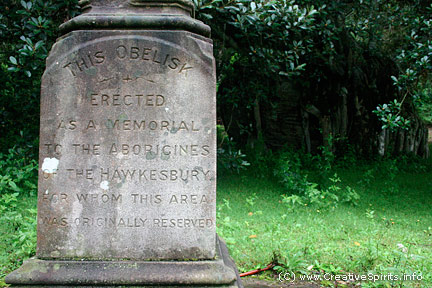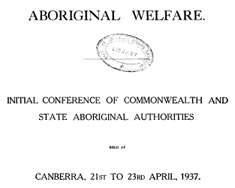History
Timeline results for white
Found 32 results for your search. Showing page 1 of 2.
Search terms: white
1790
-
The Hawkesbury and Nepean Wars between Aboriginal people and white invaders start in NSW. Led by Pemulwuy and his son Tedbury, Aboriginal people raid stations or assault sheep and cattle because the growing number of colonists occupied more and more land. Many times they used firesticks to set the bush on fire, destroy buildings, and burn crops. The guerrillia-like wars continue until 1816.

Aboriginal obelisk near the Hawkesbury River. It commemorates the Aboriginal people who occupied this area before they were wiped out by the white invaders.
1799
-
Beginning of a six-year period of resistance to white settlement by Aboriginal people in the Hawkesbury and Parramatta areas. Known as the ‘Black Wars’.
1803
-
Tasmania is occupied by white people. The Black Wars of Tasmania last until 1830 and claim the lives of 600 Aboriginal people and more than 200 white settlers.
1883
-
White parents object to about 16 Aboriginal children attending a public school at Yass. The Minister for Education, George Reid, stops the children from attending stating that although in general creed or colour should not exclude a child “cases may arise, especially amongst the Aboriginal tribes, where the admission of a child or children may be prejudicial to the whole school”.
1886
-
Men and women of the Coranderrk Aboriginal Reserve (60 kms north-east from Melbourne) fight the Aboriginal Protection Board which wants to break up the successful community that’s growing hops and doing better than neighbouring white farms. Walking to Melbourne, they deliver a petition to the Victorian government. But the majority of the residents are removed under the Protection Act which cripples Coranderrk as an enterprise. The government closes it in 1924.
1888
-
The phrase ‘ White Australia Policy’ appears in William Lane’s Boomerang newspaper in Brisbane.
1899
-
Cyclone Mahina passes over Bathurst Bay, Cape York, far north Queensland, destroys more than 70 pearl luggers and kills 12 white men and more than 300 Torres Strait Islander people who were working on them. The novel The Devil’s Eye by Ian Townsend details the devastation which was “greater than Hurricane Katrina”. The storm remains the biggest natural disaster in Australian history.
1901
-
The government introduces the white Australia policy, trying to ban all non-Caucasian people from entering the country.
1909
-
Aboriginal schools are established in NSW. Exclusion of Aboriginal children from public schools followed requests by the white community. In NSW there are 22 Aboriginal schools in 1910, 35 in 1920 and 40 in 1940. The syllabus stresses manual activities and the teacher is usually the reserve manager’s untrained wife.
1919
-
Aboriginal pastoral wages are 66% of the wages for white workers.
1928
-
Aboriginal activist and toymaker Anthony Martin Fernando (1864 - 1949) is picketing Australia House in London. Pinned to his coat
are scores of small, white, toy skeletons and he’s wearing a placard proclaiming: ‘This is all Australia has left of my people’.
1937
-

Aboriginal Welfare - Conference of Commonwealth and State Authorities called by the federal government, decides that the official policy for some Aboriginal people is assimilation policy. Aboriginal people of mixed descent are to be assimilated into white society whether they want to be or not, those not living tribally are to be educated and all others are to stay on reserves. The minutes of the meeting say:
“The destiny of the natives of aboriginal origin, but not of the full blood, lies in their ultimate absorption… with a view to their taking their place in the white community on an equal footing with the whites.” [1]
In practice, assimilation policies lead to the destruction of Aboriginal identity and culture, justification of dispossession and the removal of Aboriginal children.
In 50 years we should forget that there were any Aborigines in this country.
— A.O. Neville, Western Australian Chief Aboriginal Protector [2]
1939
-
The Queensland government establishes a leprosarium on Fantome Island (Eumilli Island) in the Great Palm Island group, about 65 km north-east of Townsville. Aboriginal patients are sent there to protect white people from catching the disease until 1973 when it is closed.
1940
-
White Australia policy succeeds: 99% of Australia’s 7 million people are white.
1950
-
The first formal schooling for Aboriginal children in the Northern Territory is provided. Lack of facilities is rationalised by the claim that children “beyond the age of 10 couldn’t keep up with white children anyway”.
1951
-
The federal government convenes the Australian Conference for Native Welfare, with all states and territories represented except Victoria and Tasmania, which claim to have no Aboriginal ‘problem’. The conference officially adopts a policy of ‘assimilation’ for Aboriginal people.
"Assimilation means, in practical terms, that it is expected that all persons of Aboriginal birth or mixed blood in Australia will live like white Australians do." [3]
1965
-
The North Australian Workers' Union applies to the Commonwealth Conciliation and Arbitration Commission to remove clauses which discriminate against Aboriginal people in the Northern Territory's pastoral award. Pastoralists meet this proposal with stiff opposition and manage to have a gradual wage adjustment implemented.
They argue a gradual increase would help Aboriginal people to 'adjust', but in fact it saves pastoralists an estimated 6 million dollars [4] over three years. The pastoralists also manage to convince the Commission to implement a 'slow worker clause' which would empower them to pay Aboriginal employees less than the standard wage when they were deemed to work less efficiently—which subsequently led to a lot of abuse of this clause.
1971
-
Dennis Walker and Sam Watson open the first and only ever Australian chapter of the Black Panther Party (an anti-racism left wing US organisation) in Brisbane. They monitor police activity and the amount of young black men vs. young white men taken into the prison system for the same crime. The party ceased in 1973. [5]
We followed Aboriginal defendants through – recording and comparing the sentencing trends so we could show that Aboriginal people were the most overarrested and overincarcerated people in the entire Australian community.
— Sam Watson, Aboriginal activist [5]
1972
-
The Whitlam (Labor) government abolishes the White Australia Policy and introduces a policy of self-determination. The change provides the right to cultural and linguistic maintenance and management of natural resources on Aboriginal land.
-
After having been in effect for more than 70 years, the government announces that the White Australia policy has ended.
When migration began here on January 26th 1788 all Australians were black and the first migrants were white and not very well selected I might say.
— Al Grassby, Minister for Immigration 1972–1974 [6]
References
View article sources (6)
[1]
National Library of Australia, nla.gov.au/nla.aus-vn118931
[2]
'Governments are attempting to steal our original sovereign citizenship and independence', First Nations Interim National Unity Government 16/6/2013
[3]
'Timeline of legislation affecting Aboriginal people', DECS Curriculum Services, www.aboriginaleducation.sa.edu.au
[4]
'Black Words, White Page: Aboriginal Literature 1929-1988', Adam Shoemaker, 2004, p.106
[5]
[5a]
'The Black Panthers Brisbane Chapter', Hell Yeah Magazine, 3rd edition, 2011 p.31
[6]
'Immigration Nation', 3-part SBS series, Part 3

